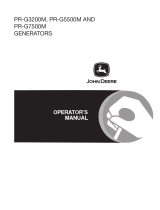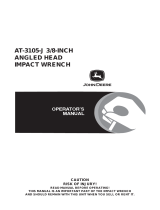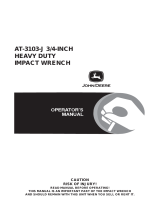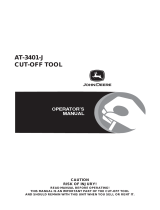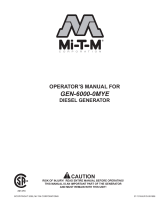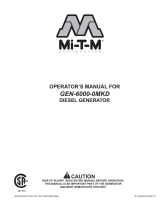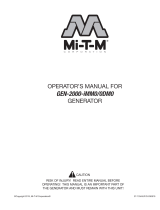Page is loading ...

Operator’s Manual 1
37-1046-E/F/S-061311©COPYRIGHT 2009, JOHN DEERE CORPORATION®
AC-G6000DY
Diesel Generator

2 Operator’s Manual
Introduction
THANK YOU for purchasing a John Deere product.
READ THIS MANUAL carefully to learn how to operate
and service your machine correctly. Failure to do so could
result in personal injury or equipment damage.
THIS MANUAL SHOULD BE CONSIDERED a permanent
part of your machine and should remain with the machine
when you sell it.
MEASUREMENTS in this manual are given in both metric
and customary U.S. unit equivalents. Use only correct
replacement parts and fasteners. Metric and inch fasten-
ers may require a specic metric or inch wrench.
RIGHT HAND AND LEFT HAND sides are determined by
facing the motor end of the machine.
The SERIAL NUMBER is located in the Specication
or Identication Numbers section. Accurately record all
the numbers to help in tracing the machine should it be
stolen. Your dealer also needs these numbers when you
order parts. File the identication numbers in a secure
place off the machine.
WARRANTY is provided from your dealer for customers
who operate and maintain their equipment as described
in this manual. The warranty is explained on the warranty
certicate shown in this manual.
This warranty provides you the assurance that your dealer
will back products where defects appear within the war-
ranty period. Should the equipment be abused, or modi-
ed to change its performance beyond the original factory
specications, the warranty will become void.
Warning: This product contains lead, a
chemical known to the State of California
to cause birth defects or other reproductive
harm.
Wash your hands after handling this product.
PROTECT YOUR INVESTMENT......
Use only John Deere Fuel Protect
Fuel Stabilizer with Ethanol Protection
TY27534 or TY27535. Developed to
ensure Optimum Performance and
Protection.
IMPORTANT...Use Year Round!
34-1904 012011

Operator’s Manual 3
Contents
Page
Safety ......................................................................... 4
Safety Signs ............................................................. 10
Controls ....................................................................11
Preparing the Generator .......................................... 12
Operation ................................................................. 17
Troubleshooting ....................................................... 21
Service ..................................................................... 22
Storage .................................................................... 26
Specications ........................................................... 26
Accessoires ................................................................ 27
Warranty ................................................................... 28
All information, illustrations and specications in this manual are based
on the latest information available at the time of publication. The right is
reserved to make changes at any time without notice.

4 Operator’s Manual
W
A
R
N
I
N
G
W
A
R
N
I
N
G
S
I
N
TH
E
M
A
N
U
A
L
S
.
W
A
R
N
I
N
G
S
I
N
TH
E
M
A
N
U
A
L
S
.
C
A
U
T
I
O
N
O
CAU
T
I
O
N
S
I
N
O
T
H
E
M
A
N
U
A
L
S
O
CAU
T
I
O
N
S
I
N
O
T
H
E
M
A
N
U
A
L
S
O
CAU
T
I
O
N
S
I
N
O
T
H
E
M
A
N
U
A
L
S
O
CAU
T
I
O
N
S
I
N
O
T
H
E
M
A
N
U
A
L
S
Safety
RECOGNIZE SAFETY INFORMATION
This is the safety alert symbol. When you see this symbol
on your machine or in this manual, be alert to the potential
for personal injury.
Follow recommended precautions and safe operating prac-
tices.
UNDERSTAND SIGNAL WORDS
A signal word--DANGER, WARNING or CAUTION--is used
with the safety-alert symbol. DANGER identies the most
serious hazards.
DANGER or WARNING safety signs are located near
specic hazards. General precautions are listed on CAU-
TION safety signs. CAUTION also calls attention to safety
messages in this manual.
FOLLOW SAFETY INSTRUCTIONS
Carefully read all safety messages in this manual and
safety signs on your machine. Keep safety signs in good
condition. Replace missing or damaged safety signs. Be
sure new equipment components and repair parts include
the current safety signs. Replacement safety signs are
available from your John Deere Customer Service Repre-
sentative.
Learn how to operate the machine and how to use controls
properly. Do not let anyone operate without instruction.
Keep your machine in proper working condition. Unauthor-
ized modications to the machine may impair the function
and/or safety and affect machine life.
If you do not understand any part of this manual and need
assistance, contact your John Deere Customer Service
Representative.

Operator’s Manual 5
CARBON MONOXIDE - POISONOUS GAS
Use generator outdoors, away from open windows, vents, or
doors.
Generator exhaust contains carbon monoxide - a poisonous
gas that can kill you. You CAN NOT smell or see this gas.
Never use a generator in enclosed or partially-enclosed spaces.
Generators can produce high levels of carbon monoxide very quick-
ly. When you use a portable generator, remember that you cannot
smell or see carbon monoxide. Even if you can’t smell exhaust
fumes, you may still be exposed to carbon monoxide.
If you start to feel sick, dizzy, or weak while using a generator, get to
fresh air RIGHT AWAY. DO NOT DELAY. The carbon monoxide from
generators can rapidly lead to full incapacitation and death.
If you experience serious symptoms, get medical attention immedi-
ately. Inform medical staff that carbon monoxide poisoning is sus-
pected. If you experienced symptoms while indoors, have someone
call the re department to determine when it is safe to re-enter the
building.
NEVER operate the generator in an explosive atmosphere, near
combustible materials or where ventilation is not sufcient to carry
away exhaust fumes. Exhaust fumes can cause serious injury or
death.
NEVER use a generator indoors, including in homes, garages,
basements, crawl spaces, and other enclosed or partially-enclosed
areas, even with ventilation. Opening doors and windows or using
fans will not prevent carbon monoxide build-up in the home.
Follow the instructions that come with your generator. Locate the
unit outdoors and away from doors, windows, and vents that could
allow the carbon monoxide gas to come indoors.
ONLY run generator outdoors and away from air intakes.
NEVER run generator inside homes, garages, sheds, or other semi-
enclosed spaces. These spaces can trap poisonous gases EVEN
IF you run a fan or open doors and windows.
If you start to feel sick, dizzy, or weak while using the generator,
shut if off and get fresh air RIGHT AWAY. See a doctor. You may
have carbon monoxide poisoning.
Install battery-operated carbon monoxide alarms or plug-in carbon
monoxide alarms with battery back-up in your home, according to
the manufacturer’s installation instructions. The carbon monoxide
alarms should be certied to the requirements of the latest safety
standards for carbon monoxide alarms. (UL 2034, IAS 6-96, or CSA
6.19.01).
Test your carbon monoxide alarm frequently and replace dead bat-
teries.

6 Operator’s Manual
SAFETY WARNING WHEN REFUELING
Diesel fuel is extremely ammable and its vapors can explode if ignited.
Observe all safety regulations for the safe handling of fuel. Handle fuel in
safety containers. If the container does not have a spout, use a funnel.
Do not overll the fuel tank, leave room for the fuel to expand.
Do not rell fuel tank while the engine is running. Before refueling the
generator, turn it off and let it cool down. Diesel fuel spilled on hot engine
parts could ignite.
Fill the tank only on an area of bare ground. While fueling the tank, keep
heat, sparks and open ame away. Carefully clean up any spilled fuel
before starting engine.
Always ll fuel tank in an area with plenty of ventilation to avoid inhaling
dangerous fumes.
NEVER store fuel for your generator in the home. Diesel fuel, propane,
kerosene, and other ammable liquids should be stored outside of living
areas in properly-labeled, non-glass safety containers. Do not store them
near a fuel-burning appliance, such as a natural gas water heater in a ga-
rage. If the fuel is spilled or the container is not sealed properly, invisible
vapors from the fuel can travel along the ground and can be ignited by the
appliance’s pilot light or by arcs from electric switches in the appliance.
GROUND FAULT CIRCUIT INTERRUPTER PROTECTION
These generators are equipped with two GFCI (Ground Fault Circuit
Interrupters) 120V duplex receptacles for protection against the hazards
of electrical shock from defective attachments such as, tools, cords, and
cables.
WARNING: THE GFCIS MAY NOT FUNCTION UNLESS THE
GENERATOR IS PROPERLY GROUNDED. FOLLOW THE
CORRECT PROCEDURE SPECIFIED IN THE SECTION
LABELED “GROUNDING INSTRUCTIONS”
A GFCI is a device that interrupts electricity from either the utility or gen-
erator by means of a special type of circuit breaker if a fault current ow
to the ground occurs.
WARNING: ONLY THE 120V DUPLEX RECEPTACLES ARE
PROTECTED BY THE GFCI.
A GFCI can be used only with generators that have the neutral wire
internally bonded to the frame, and the frame properly grounded to the
earth. A GFCI will not work on generators that do not have the neutral
wire bonded to the frame, or on generators which have not been prop-
erly grounded. All John Deere generators have internally bonded ground
wires. A GFCI will not work if the unit is not properly grounded.
A GFCI may be required by OSHA regulations, the National Electric
Code and/or local and federal codes when operating a generator.
For additional protections against shock hazards due to defective equip-
ment attached to the twist-lock receptacles, consider the use of a GFCI
on each of these receptacles as well.
GFCIs and GFCI protected cord sets and cables may be purchased from
local electrical supply houses.

Operator’s Manual 7
ELECTRICAL HAZARDS
This product must be grounded. It has permanent conductor between
the generator (stator winding) and the frame. If it should malfunction or
breakdown, grounding provides a path of least resistance for electric
current to reduce the risk of electric shock.
DANGER - IMPROPER CONNECTION OF THE EQUIPMENT-
GROUNDING CONDUCTOR CAN RESULT IN A RISK
OF ELECTROCUTION. CHECK WITH A QUALIFIED
ELECTRICIAN OR SERVICE PERSON IF YOU ARE INDOUBT
AS TO WHETHER THE UNIT IS PROPERLY GROUNDED.
This generator is equipped with a grounding terminal for your protec-
tion. Always complete the ground path from the generator to an external
ground source as instructed in the section labeled “Grounding Instruc-
tions” in the Preparation section of this manual.
The generator is a potential source of electrical shock if not kept dry.
Keep the generator dry and do not use in rain or wet conditions. To pro-
tect from moisture, operate it on a dry surface under an open, canopy-
like structure. Dry your hands if wet before touching the generator.
Risk of electric shock if you operate this generator with a faulty GFCI
(Ground Fault Circuit Interrupter). Test GFCI before each use, see Op-
erations Instructions for further information. If GFCI fails test, DO NOT
use your generator. Contact your John Deere Customer Service Repre-
sentative.
Plug appliances directly into the generator. Or, use a heavy duty, out-
door-rated extension cord that is rated (in watts or amps) at least equal
to the sum of the connected appliance loads. Check that the entire cord
is free of cuts or tears and that the plug has all three prongs, especially
a grounding pin.
NEVER try to power the house wiring by plugging the generator into
a wall outlet, a practice known as “back feeding”. This is an extremely
dangerous practice that presents an electrocution risk to utility workers
and neighbors served by the same utility transformer. It also bypasses
some of the built-in household circuit protection devices.
If you must connect the generator to the house wiring to power appli-
ances, have a qualied electrician install the appropriate equipment in
accordance with local electrical codes. Or, check with your utility com-
pany to see if it can install an appropriate power transfer switch.
For power outages, permanently installed stationary generators are
better suited for providing backup power to the home. Even a properly
connected portable generator can become overloaded. This may result
in overheating or stressing the generator components, possibly leading
to a generator failure.

8 Operator’s Manual
IMPORTANT SAFETY INSTRUCTIONS
WARNING: To reduce the risk of injury, read this operator’s
manual completely before using. When using this product, the
following basic precautions should always be followed:
1. Read all the instructions before using the product.
2. This product is equipped with a Ground Fault Circuit Interrupter
(GFCI) in the power cord to reduce the risk of electrical shock.
If replacement of the plug or cord is needed, use only identical
replacement parts.
3. Do not allow children or untrained persons to operate the
generator.
4. Do not operate the generator when fatigued or under the
inuence of drugs or chemicals. Stay alert. Watch what you
are doing.
5. Follow the maintenance instructions specified in this
manual.
6. When starting the generator, using recoil starter grip, be sure
that nothing is in a position to be hit by the operator’s hand
or arm.
7. Be sure the switch on electric power tools is in the “OFF”
position before plugging them into the generator.
8. Keep the immediate area free of all bystanders.
9. Be sure each person who operates this generator is properly
instructed in its safe operation.
10. Do not operate the generator or any electrical tool in any
area where water or similar materials constitute an electrical
hazard to the operator. Do not operate on wet surfaces, in
rain or in snow.
11. Always be sure that the generator is on secure footing so
that it cannot slide or shift around, endangering workers.
12. Avoid contacting the hot exhaust manifold, mufer or
cylinder(s). Keep clear of all rotating parts.
13. Unless the tool or appliance is double insulated, it must be
grounded through a properly grounded receptacle. (See
Preparing the Generator, Grounding Instructions). Tools and
appliances which have 3 prong plugs must be plugged into
extension cords and electrical receptacles with 3 holes. Before
operating any electrical item, be sure it is in good repair.
14. Follow instructions in this manual when testing Ground Fault
Circuit Interrupter to insure reliable operation.
15. Beware of using this equipment in confined spaces.
Conned spaces, without sufcient fresh air ventilation, can
contain dangerous gases. Running diesel fuel engines in
such environments can lead to deadly explosions and/or
asphyxiation.
16. If your generator comes equipped with a transport dolly,
make sure this unit is secure during operation and when
transporting to prevent unexpected movement or rolling.
17. Use extreme caution when lifting this generator. Do not use
dolly handles to lift this generator, use only designated lifting
hook to lift this generator. This generator is heavy so proper
lifting techniques should be used.
SAVE THESE INSTRUCTIONS
W
A
R
N
I
N
G
W
A
R
N
I
N
G
S
I
N
TH
E
M
A
N
U
A
L
S
.
W
A
R
N
I
N
G
S
I
N
TH
E
M
A
N
U
A
L
S
.
C
A
U
T
I
O
N
O
CAU
T
I
O
N
S
I
N
O
T
H
E
M
A
N
UA
L
S
O
CAU
T
I
O
N
S
I
N
O
T
H
E
M
A
N
UA
L
S
O
CAU
T
I
O
N
S
I
N
O
T
H
E
M
A
N
UA
L
S
O
CAU
T
I
O
N
S
I
N
O
T
H
E
M
A
N
UA
L
S

Operator’s Manual 9
WEAR PROTECTIVE CLOTHING
Wear close tting clothing and safety equipment appropri-
ate to the job.
Wear a suitable hearing protective device such as earmuffs
or earplugs to protect against objectionable or uncomfort-
able loud noises.
Operating equipment safely requires the full attention of
the operator. Do not wear radio or music headphones while
operating machine.
INSPECT GENERATOR
Be sure all covers, guards and shields are tight and in
place.
Locate all operating controls and safety labels.
Inspect power cord for damage before using. There is a
hazard of electrical shock from crushing, cutting or heat
damage.
PREPARE FOR EMERGENCIES
Keep a rst aid kit and re extinguisher handy.
Keep emergency numbers for doctors, ambulance ser-
vice, hospital and re department near your telephone.
Be prepared if a re starts.
SERVICE GENERATOR SAFELY
Before servicing the generator, disconnect all equipment
and battery (if equipped) and allow unit to cool down.
Service generator in a clean dry at area.

10 Operator’s Manual
SAFETY SIGNS
34-1916-031607-E-F-S.
Using a generator indoors CAN KILL YOU IN MINUTES.
Generator exhaust contains carbon monoxide. This is a
poison you cannot see or smell.
NEVER use inside a home
or garage, EVEN IF doors
and windows are open.
Only use OUTSIDE and far
away from windows, doors,
and vents.
DANGER DANGER PELIGRO
Utilizando un generador adentro
PUEDE MATARLE EN MINUTOS.
El escape de generador contiene
monóxido de carbono. Este es un
gas tóxico que usted no puede ver ni
puede oler.
Nunca utilice dentro de un hogar ni el
garaje, INCLUSO SI puertas y
ventanas estén abiertas.
Solo utilice AFUERAS y lejos de
ventanas abiertas, las puertas, y
descargas.
L'utilisation d'un groupe électrogène à
l'intérieur PEUT VOUS TUER EN
QUELQUES MINUTES.
Le gaz d'échappement du groupe
électrogène contient de l'oxyde de
carbone. C'est un gaz toxique que l'on
ne peut pas voir ou sentir.
Ne JAMAIS utiliser à l'intérieur d'une
maison ou d'un garage, MÊME SI les
portes et fenêtres s'ont ouvertes.
N'utiliser qu'à l'EXTÉRIEUR et bien éloigné
des fenêtres, portes, et conduits d'aération.
GND
34-0889
062104-ENG.
OPERATION
Read unit Operator's Manual carefully before operating this
unit. Always make sure unit is level and properly grounded.
Check engine oil before starting.
START-UP:
1. Open fuel valve.
2. Move engine speed control to the run position.
3. Turn the key to start position, release as soon as it starts.
4. Allow unit to warm-up (2 min.) before applying load.
5. Turn main breaker ON to main position.
SHUT-DOWN:
1. Remove all electrical loads by turning off and unplugging
cords.
2. Turn key to off position.
3. Depress stop lever on engine speed control.
4. Close fuel valve.
*For recoil start see engine manual.
D'UTILISATION OPERACIÓN
Lire soigneusement le manuel de l'utilisateur avant de se servir de l'appareil.
S'assurer toujours que l'appareil est sur une surface plane et qu'il est correctement
relié à la terre. Vérifier le niveau d'huile du moteur avant le démarrage. *Pour un
démarrage avec lanceur à rappel, voir le manuel du moteur.
DEMARRAGE:
1. Ouvrir la soupape de carburant de l'appareil ou du moteur.
2. Placer la commande de régime du moteur en position de marche.
3. Tourner la clef jusquà la position de démarrage, puis la relâcher dés le démarrage.
4. Permettre à l'appareil de tourner pendant deux (2) minutes pour qu'il se
réchauffe avant d'appliquer une charge.
5. Toumer l’disjoncteur de secteur sur la position marche (ON).
ARRET:
1. Supprimer toutes les charges électriques en éteignant et en
débranchant les raccords électriques.
2. Tourner la clef jusqu'à la position d'arrêt.
3. Abaisser le levier d'arrêt de la commande de régime du moteur.
4. Fermer la soupape de carburant sur l'appareil ou le moteur.
Lea manual de operador antes de operar esta unidad. Siempre asegúrese que
unidad sea plana y conecte a tierra correcto. Revise el
aceite de motor antes de empezando. *Para arranque de retroceso vea el
manual de motor.
OPERACIÓN:
1. Abra válvula de comestible en unidad o motor.
2. Mueva el control de la velocidad de motor a la posición de función.
3. Gire la llave a la posición de arranque, solte tan pronto como lo comienza.
4. Permite 2(min) para calentarse de la unidad antes de aplicando la carga.
5. Dble cortacircuitos principal a posició de ON.
ARRET:
1. Quite todas cargas eléctricas como apagando y desenchufando las cuerdas.
2. Gire el interruptor de la llave a la posición de OFF.
3. Deprima la palanca de parada en el control de la velocidad de motor.
4. Cierre válvula de comestible en unidad o motor.
TEST GFCI RECEPTICAL(S) BEFORE EACH USE. SEE OPERATORS MANUAL FOR INSTRUCTIONS.
EXAMINEZ GFCI RECEPTICAL AVANT CHAQUE UTILISATION. VOIR LES OPÉRATEURS MANUELS POUR DES INSTRUCTIONS.
PRUEBE GFCI RECEPTICAL ANTES DE CADA USO. VEA A LOS OPERADORES MANUALES PARA LAS INSTRUCCIONES.
NEUTRAL BONDED TO FRAME
COLLÉ NEUTRE À L’ARMATURE
CONSOLIDADO NEUTRAL AL MARCO
HOURMETER
COMPTEUR HORAIRE
CONTADOR HORARIO
20 AMP
CIRCUIT BREAKER
DISJONCTEUR
DISYUNTOR
125 VOLT - 20 AMP
125 VOLT - 20 AMPÈRE
125 VOLTIO - 20 AMPERIO
20 AMP
CIRCUIT BREAKER
DISJONCTEUR
DISYUNTOR
125 VOLT - 20 AMP
125 VOLT - 20 AMPÈRE
125 VOLTIO - 20 AMPERIO
20 AMP
CIRCUIT BREAKER
DISJONCTEUR
DISYUNTOR
MAIN CIRCUIT BREAKER
DISJONCTEUR DE SECTEUR
CORTACIRCUITOS PRINCIPAL
125/250 VOLT - 20 AMP
125/250 VOLT - 20 AMPÈRE
125/250 VOLTIO - 20 AMPERIO
30 AMP
CIRCUIT BREAKER
DISJONCTEUR
DISYUNTOR
125 VOLT - 30 AMP
125 VOLT - 30 AMPÈRE
125 VOLTIO - 30 AMPERIO
34-2324 E-F-S 010908
34-1916
34-1676
34-2324
34-0889

Operator’s Manual 11
Controls
CONTROLS
A -- Fuel Tank
B -- Control Panel
C -- Oil Drain Plug
D -- Fuel Cap
D
C
A
B
E -- Oil Filler Port
E

12 Operator’s Manual
Preparing the Generator
GROUNDING INSTRUCTIONS
This product must be grounded. If it should malfunction or
breakdown, grounding provides a path of least resistance
for electric current to reduce the risk of electric shock.
DANGER - IMPROPER CONNECTION OF THE
EQUIPMENT-GROUNDING CONDUCTOR CAN
RESULT IN A RISK OF ELECTROCUTION.
CHECK WITH A QUALIFIED ELECTRICIAN
OR SERVICE PERSON IF YOU ARE IN DOUBT
AS TO WHETHER THE UNIT IS PROPERLY
GROUNDED.
The wing nut and ground terminal on the frame must
always be used to connect the generator to a suitable
ground source. The ground path should be made with #8
size wire. Connect the terminal of the ground wire be-
tween the two star washers and wing nut then tighten the
wing nut fully. Connect the other end of the wire securely
to a suitable ground source.
The National Electric Code contains several practical
ways in which to establish a good ground source. Ex-
amples given below illustrate a few of the ways in which a
good ground source may be established.
A metal underground water pipe in direct contact with
the earth for at least 10 feet can be used as a ground-
ing source. If an pipe is unavailable, an 8 foot length of
pipe or rod may be used as the ground source. The pipe
should be 3/4 inch trade size or larger and the outer
surface must be noncorrosive. If a steel or iron rod is used
it should be at least 5/8 inch diameter and if a nonferrous
rod is used it should be at least 1/2 inch diameter and be
listed as material for grounding. Drive the rod or pipe to a
depth of 8 feet. If a rock bottom is encountered less than
4 feet down, bury the rod or pipe in a trench. All electrical
tools and appliances operated from this generator, must
be properly grounded by use of a third wire or be “Double
Insulated”.
It is recommended to:
1. Use electrical devices with 3 prong power cords.
2. Use an extension cord with a 3 hole receptacle and a 3
prong plug at the opposite ends to ensure continuity of
the ground protection from the generator to appliance.
We strongly recommend that all applicable federal, state
and local regulations relating to grounding specications
be checked and followed.
LINE TRANSFER SWITCH
If this generator is used for standby service, it must have
a transfer switch between the utility power service and the
generator. The transfer switch not only prevents the utility
power form feeding into the generator, but is also prevents
the generator form feeding out into the utility company’s
lines. This is intended to protect the serviceman who may
be working on a damaged line.
THIS INSTALLATION MUST BE DONE BY A LICENSED
ELECTRICIAN AND ALL LOCAL CODES MUST BE
GND
34-0889
062104-ENG.

Preparing the Generator
Operator’s Manual 13
v
FOLLOWED.
ENGINE OIL
CAUTION: ONLY USE THE ENGINE OIL
SPECIFIED. OTHER ENGINE OILS MAY
AFFECT WARRANTY COVERAGE, CAUSE
INTERNAL ENGINE COMPONENTS TO SEIZE,
OR SHORTEN ENGINE LIFE.
PREVENT DIRT AND DEBRIS FROM
CONTAMINATING THE ENGINE OIL.
CAREFULLY CLEAN THE OIL CAP/DIPSTICK
AND THE SURROUNDING AREA BEFORE YOU
REMOVE THE CAP.
NEVER MIX DIFFERENT TYPES OF ENGINE
OIL. THIS MAY ADVERSELY AFFECT THE
LUBRICATING PROPERTIES OF THE ENGINE
OIL.
NEVER OVERFILL. OVERFILING MAY RESULT
IN WHITE EXHAUST SMOKE, ENGINE
OVERSPEED OR INTERNAL DAMAGE.
ENGINE OIL SPECIFICATIONS
Use an engine oil that meets or exceeds the following
guidelines and classications:
SERVICE CATEGORIES
• API Service Categories CD or higher
• ACEA Service Categories E-3, E-4, and E-5
• JASO (Japanese Automobile Standards Organiza
tions)
NOTES:
1. Be sure the engine oil, engine oil storage containers,
and engine oil lling equipment are free of sediments
and water.
2. Change the engine oil after the rst 50 hours of operation
and then at every 200 hours thereafter.
3. Select the oil viscosity based on the ambient temperature
where the engine is being operated. See SAE Service
Grade Viscosity Chart.
4. Yanmar does not recommend the use of engine oil
“additives”.
ENGINE OIL VISCOSITY
Select the appropriate engine oil viscosity based on the
ambient temperature and use the SAE Service Grade
Viscosity Chart.
TO FILL WITH OIL:
1. Make sure engine is level.
2. Remove oil cap/dipstick from either location and wipe
with clean cloth.
3. Add indicated amount of engine oil at either one of the
engine oil ller ports.
°F -4 14 32 50 68 86 104
°C -20 -10 0 10 20 30 40
SAE 10W
SAE 20W
SAE 10W-30
SAE 15W-40
SAE 20
SAE 30
SAE 40
TEMPERATURE CHART

Preparing the Generator
14 Operator’s Manual
4. Wait one minute and check oil level.
5. Add more oil if necessary.
6. Fully reinsert oil cap/dipstick and hand tighten. Over-
tightening the oil cap/dipstick will damage it.
ENGINE OIL CAPACITY (TYPICAL)
The following is the engine oil capacity for various Yanmar
LV Series engines.
FUELING
WARNING: EXPLOSIVE FUEL!
DIESEL FUEL IS EXTREMELY FLAMMABLE
AND ITS VAPORS CAN EXPLODE IF IGNITED.
STORE DIESEL FUEL ONLY IN APPROVED
CONTAINERS, IN WELL VENTILATED,
UNOCCUPIED BUILDINGS AND AWAY FROM
SPARKS OR FLAMES.
DO NOT FILL THE FUEL TANK WHILE
THE ENGINE IS HOT OR RUNNING, SINCE
SPILLED FUEL COULD IGNITE IF IT COMES
IN CONTACT WITH HOT PARTS OR SPARKS
FROM IGNITION. DO NOT START THE ENGINE
NEAR SPILLED FUEL.
NEVER USE DIESEL FUEL AS A CLEANING
AGENT.
WARNING: DO NOT OVERFILL THE FUEL
TANK, LEAVE ROOM FOR THE FUEL TO
EXPAND.
GENERAL RECOMMENDATIONS
Purchase diesel fuel in small quantities and store in clean,
approved containers.
To minimize gum deposits in your fuel system and to
insure easy starting, do not use diesel fuel left over from
the previous season.
Do not add oil to the diesel fuel.
DIESEL FUEL SPECIFICATIONS
Diesel fuel should comply with the following specications.
The table lists several worldwide specications for diesel
fuels.
MODEL # DIPSTICK UPPER LIMIT/
LOWER LIMIT
L100V 1.7/1.06 QT (1.6/1.0L)
Diesel Fuel Specication Location
No. 2-D, No.1-D, ASTM D975-94 USA
EN590:96 European Union
ISO 8217 DMX International
BS 2869-A1 or A2 United Kingdom
JIS K2204 Grade No. 2 Japan
KSM-2610 Korea
GB252 China

Preparing the Generator
Operator’s Manual 15
ADDITIONAL TECHNICAL FUEL REQUIREMENTS
• The fuel cetane number should be equal to 45 or
higher.
• The sulfur content must not exceed 0.5% by volume
Less than 0.05% is preferred.
• Bio-Diesel fuels. See below.
• Never mix kerosene, used engine oil, or residual
fuels with the diesel fuel.
• Water and sediment in the fuel should not exceed
0.05% by volume.
• Keep the fuel tank and fuel-handling equipment
clean at all times.
• Poor quality fuel can reduce engine performance
and/or cause engine damage.
• Fuel additives are not recommended. Some fuel
additives may cause poor engine performance. Con
sult your Yanmar representative for more informa
tion.
• Ash content not to exceed 0.01% by volume.
• Carbon residue content not to exceed 0.35% by
volume. Less than 0.1% is preferred.
• Total aromatics content should not exceed 35% by
volume. Less than 30% is preferred.
• PAH (polycyclic aromatic hydrocarbons) content
should be below 10% volume.
• Metal content of Na, Mg, Si, and Al should be equal
to or lower than 1 mass ppm. (Test analysis method
JPI-5S-44-95)
BIO-DIESEL FUELS
In Europe and the United States, as well as some other
countries, non-mineral oil based fuel resources such as
RME (Rapeseed Methyl Ester) and SOME (Soybean
Methyl Ester), collectively known as FAME (Fatty Acid
Methyl Esters), are being used as extenders for mineral
oil derived diesel fuels.
Yanmar approves the use of bio-diesel fuels that do not
exceed a blend of 5% (by volume) of FAME with 95% (by
volume) of approved mineral oil derived diesel fuel. Such
bio-fuels are known in the marketplace as B5 fuels.
These B5 diesel fuels must meet certain require-
ments.
1. The bio-fuels must meet the minimum specications for
the country in which they are used.
• In Europe, bio-diesel fuels must comply with the
European Standard EN14214.
• In the United States, bio-fuels must comply with the
American Standard ASTM D-6751.
2. Bio-fuels should be purchased only from recognized and
authorized diesel fuel suppliers.
PRECAUTIONS AND CONCERNS REGARDING THE
USE OF BIO-FUELS:
1. Free methanol in FAME may result in corrosion of
aluminum and zinc FIE components.

Preparing the Generator
16 Operator’s Manual
2. Free water in FAME may result in plugging of fuel lters
and increased bacterial growth.
3. High viscosity at low temperatures may result in fuel
delivery problems, injection pump seizures, and poor
injection nozzle spray atomization.
4. FAME may have adverse effect on some elastomers (seal
materials) and may result in fuel leakage and dilution of
the engine lubricating oil.
5. Even bio-diesel fuels that comply with a suitable standard
as delivered, will require additional care and attention to
maintain the quality of the fuel in the equipment or other
fuel tanks. It is important to maintain a supply of clean,
fresh fuel. Regular ushing of the fuel system, and/or
fuel storage containers, may be necessary.
6. The use of bio-diesel fuels that do not comply with
the standards as agreed to by the diesel engine
manufacturers and the diesel fuel injection equipment
manufacturers, or bio-diesel fuels that have degraded
as per the precautions and concerns above may affect
the warranty coverage of your engine.
BATTERY INSTALLATION
WARNING: SHOULD ONLY BE DONE BY AN
AUTHORIZED DEALER.
HIGH ALTITUDE
Observe the following environmental operating conditions
to maintain engine performance and avoid premature
engine wear:
• Never run the engine if the ambient temperature is
above +104ºF (+40ºC) or below +14ºF (-10ºC).
• If the ambient temperature exceeds +104ºF (+40ºC)
the engine may overheat and cause the engine oil to
break down.
• If the ambient temperature falls below +14ºF (-
10ºC) rubber components such as gaskets and
seals will harden causing premature engine wear
and damage.
• Contact your authorized Yanmar industrial engine
dealer or distributor if the engine will be operated in
either temperature extreme.
• Contact your authorized Yanmar industrial engine
dealer or distributor if you need to operate the en
gine at high altitudes. At high altitudes the engine
will lose power, run rough, and produce exhaust
gases that exceed the design specications.
BATTERY REPLACEMENT #
32-0058

Operator’s Manual 17
OPERATION
RECOIL START
NOTE: Read Operator’s Manual carefully before
operating this unit. Always make sure the unit
is level and properly grounded. Check engine
oil before starting.
ELECTRIC START
CAUTION:NEVER USE AN ENGINE STARTING
AID SUCH AS ETHER. ENGINE DAMAGE WILL
RESULT.
Use the following procedure to start the engine.
1. Make sure the fuel cock is in the ON position.
2. Set engine speed control to RUN
3. Insert the key into the key switch.
4. Turn the key clockwise to the START position. Release
the key as soon as the engine starts. It will return to the
ON position.
5. If the engine fails to start:
a. Wait until the engine comes to a complete stop before
you attempt to start it again. Engaging the starter
while the engine is still rotating will result in damage
to the starter motor and ywheel.
b. Wait at least 30 seconds before you attempt to start
the engine again. This pause will allow the battery
voltage to recover to prevent damage to the starter
motor due to the low battery voltage.
6. Allow the unit to run for two (2) minute warm-up.
7. Turn main breaker to ON position (GEN-6000 units
only).
8. Test the GFCI receptacle(s) on the unit. Push the test
button. The reset button should pop out and there should
be no power at the receptacle. Apply a test load or lamp to
each receptacle to verify. IF THE RESET BUTTON DOES
NOT POP OUT, DO NOT USE THE RECEPTACLES(S).
SEE DEALER FOR SERVICE IMMEDIATELY.
9. If GFCI receptacle(s) test correctly, rmly push the reset
button to restore power. A distinctive click should be heard
or felt when this is complete. IF THE RECEPTACLE(S)
DO NOT RESET PROPERLY, DO NOT USE THE
RECEPTACLE(S). SEE DEALER FOR SERVICE
IMMEDIATELY.
SHUTDOWN
CAUTION: FOR MAXIMUM ENGINE LIFE,
YANMAR RECOMMENDS THAT WHEN
SHUTTING THE ENGINE DOWN, YOU ALLOW
THE ENGINE TO IDLE, WITHOUT LOAD,
FOR 5 MINUTES. THIS WILL ALLOW THE
ENGINE COMPONENTS THAT OPERATE
Operation

Operating the Generator
18 Operator’s Manual
AT HIGH TEMPERATURES, SUCH AS THE
TURBOCHARGER (IF EQUIPPED) AND
EXHAUST SYSTEM, TO COOL SLIGHTLY
BEFORE THE ENGINE ITSELF IS SHUT DOWN.
Set Engine Speed Control to STOP
CAUTION: IF THE ENGINE CONTINUES TO
RUN AFTER YOU POSITION THE ENGINE
SPEED CONTROL TO THE STOP POSITION,
TURN THE FUEL COCK TO THE CLOSED
POSITION.
1. Press the Speed Control knob to STOP and the engine
speed control lever will automatically return to the STOP
position.
Note: The speed control lever is spring -loaded so
when you push down on the STOP button, the
speed control lever moves back to the shut-off
position. There is no idle position or intermediate
speeds.
ELECTRIC START MODELS
Turn the key to the OFF position and remove it from the
key switch.
AFTER THE ENGINE STOPS
1. Move the fuel cock lever to the closed position.
2. Slowly pull the recoil starter handle out to the point of
resistance (the point in the compression stroke where
the intake and exhaust valves are closed). This helps
to prevent rust while the engine is not in use.
3. If the engine will not be used for six months or longer,
follow the additional instructions on storage.
CONTROLS
CONTROL PANEL :
The generator is equipped with the following items:
• Hour Meter
• Volt Meter
• Circuit Breakers
• Two 125 Volt, 20 Amp, Duplex (2 outlets), GFCI
protected receptacles.
• One 125 Volt, 30 Amp, Locking Type Receptacle.
• One 125/250 Volt, 20 Amp, Locking Type Recep
tacle
NOTE: The 125 Volt, 30 Amp and 125/250 Volt, 20
Amp locking receptacles ARE NOT GROUND
FAULT PROTECTED. If ground fault protection
on these receptacles is necessary or desired,
external protection devices must be used.
Refer to the section on “Ground Fault Inter-
rupter” for more information.

Operating the Generator
Operator’s Manual 19
WARNING: NEVER EXCEED THE RATING OF A
RECEPTACLE.
These receptacles are protected against over-
loads by resetting magnetic type circuit break-
ers. If a circuit breaker trips, the cause should
be determined and corrected prior to continu-
ing use.
HOUR METER:
These generators are equipped with an hour meter that
records run time for the unit. This is very useful in sched-
uling maintenance. See periodic maintenance chart for
suggested maintenance schedule.
VOLT METER:
These generators are equipped with a volt meter. The volt
meter is used to monitor the unit for proper voltage.
MAIN BREAKER:
These generators are equipped with a main circuit break-
er which protects the unit in an overload condition. This
main breaker must be “ON” for any power to be drawn
from the unit.
CABLE SIZE:
Equipment damage can result from low voltage. There-
fore, to prevent excessive voltage drop between the
generator and the equipment, the cable should be of
adequate gauge for the length used. The cable selection
chart gives the maximum cable lengths for various gauges
of wire which can adequately carry the loads shown.
ELECTRIC MOTOR LOADS:
It is characteristic of common electric motors in normal
operation to draw up to six times their running current
while starting. This table may be used to estimate the
watts required to start “CODE G” electric motors.
CAUTION: IF AN ELECTRIC MOTOR FAILS TO
START OR REACH RUNNING SPEED, TURN
OFF THE APPLIANCE OR TOOL IMMEDIATELY
TO AVOID EQUIPMENT DAMAGE. ALWAYS
CHECK THE REQUIREMENTS OF THE TOOL
OR APPLIANCE BEING USED COMPARED TO
THE RATED OUTPUT OF THE GENERATOR.

Operating the Generator
20 Operator’s Manual
CURRENT LOAD IN WATTS MAXIMUM CABLE LENGTH (FEET)
IN AMPS 120 VOLTS 240 VOLTS #8 WIRE #10 WIRE #12 WIRE #14 WIRE #16 WIRE
2.5 300 600 1000 600 375 250
5 600 1200 500 300 200 125
7.5 900 1800 350 200 125 100
10 1200 2400 250 150 100 50
15 1800 3600 150 100 65
20 2400 4800 175 125 75 50
25 3000 6000 150 100 60
30 3600 7200 125 65
40 4800 9600 90
WATTS REQUIRED TO START MOTOR
MOTOR (H.P.) RUNNING WATTS REPULSION INDUCTION CAPACITOR SPLIT PHASE
1/8 275 600 850 1200
1/6 275 600 850 2050
1/4 400 850 1050 2400
1/3 450 975 1350 2700
1/2 600 1300 1800 3600
3/4 850 1900 2600
1 1100 2500 3300
/






